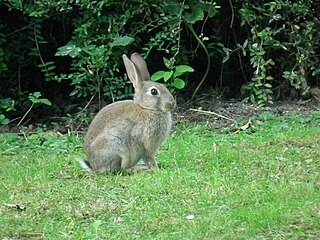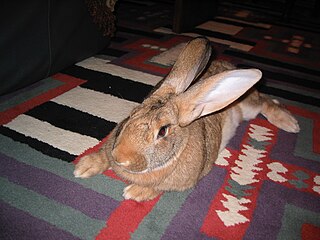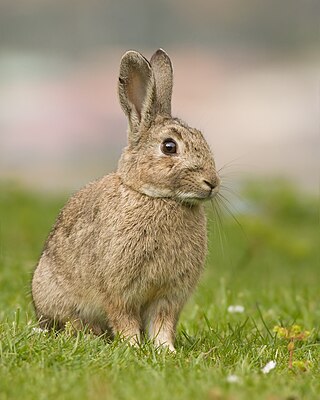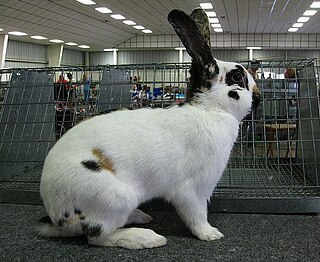
Rabbits, also known as bunnies or bunny rabbits, are small mammals in the family Leporidae of the order Lagomorpha. Oryctolagus cuniculus includes the European rabbit species and its descendants, the world's 305 breeds of domestic rabbit. Sylvilagus includes 13 wild rabbit species, among them the seven types of cottontail. The European rabbit, which has been introduced on every continent except Antarctica, is familiar throughout the world as a wild prey animal and as a domesticated form of livestock and pet. With its widespread effect on ecologies and cultures, the rabbit is, in many areas of the world, a part of daily life—as food, clothing, a companion, and a source of artistic inspiration.

The Angora rabbit, which is one of the oldest types of domestic rabbit, is bred for the long fibers of its coat, known as Angora wool, which are gathered by shearing, combing or plucking. Because rabbits do not possess the same allergy-causing qualities as many other animals, their wool is an important alternative. There are at least 11 distinct breeds of Angora rabbit, four of which are currently recognized by the American Rabbit Breeders Association (ARBA): English Angora, French Angora, Giant Angora and Satin Angora. Others include German Angora, Chinese Angora, Finnish Angora, Japanese Angora, Korean Angora, Russian Angora, St Lucian Angora and Swiss Angora.

Oryctolagus is a genus of lagomorph that today contains the European rabbit and its descendant, the domestic rabbit, as well as several fossil species.

The Netherland Dwarf is a breed of domestic rabbit that originated in the Netherlands. Weighing 1.1–2.5 pounds (0.50–1.13 kg), the Netherland Dwarf is one of the smallest rabbit breeds. Its popularity as a pet or show rabbit may stem from its neotenic appearance. The Netherland Dwarf is recognised by both the American Rabbit Breeders Association (ARBA) and the British Rabbit Council (BRC). The Netherland Dwarf is often confused with the Polish breed of rabbit, but the latter has longer ears, a non-brachycephalic head and less cobbiness.

The Californian, also known as the California White, is a breed of domestic rabbit originally developed for the fur and meat industries by George S. West of Lynwood, California, starting in 1923. Mr. West maintained a herd of 300 genetically pure New Zealand Whites, which he began crossing with Standard Chinchilla rabbits and Himalayan rabbits. His new breed, named for the state of its origin, was first shown in 1928 and a standard was accepted by the American Rabbit Breeders Association (ARBA) in 1939.

The Sumatran striped rabbit, also known as the Sumatra short-eared rabbit or Sumatran rabbit, is a rabbit found only in forests in the Barisan Mountains in western Sumatra, Indonesia, and surrounding areas. It is threatened by habitat loss.

The Mini Lop is a breed of domestic rabbit that is recognized by the American Rabbit Breeders Association (ARBA). It is different from the Miniature Lop breed that is recognized by the British Rabbit Council (BRC). The Mini Lop [US] and the Miniature Lop [UK] are different from the Dwarf Lop breed that is recognized by the BRC. The Mini Lop is similar to several other small rabbit breeds, such as the Dwarf rabbit.

Holland Lop is a breed of rabbit that was recognized by the American Rabbit Breeders Association (ARBA) in 1979. The Holland Lop, with a maximum weight of 4 lb (1.8 kg), is one of the smallest lop-eared breeds.
Chinchilla rabbits are a group of three rabbit breeds that have been bred for a coat that resembles that of chinchillas. Despite their name, they are not related to and cannot interbreed with chinchillas, which are a species of rodent. Rabbits are lagomorphs. A mutation diluted the yellow pigment in the hairs to almost white, changing in this way the color of the fur of the wild rabbit (agouti) into chinchilla.

The Flemish Giant rabbit is the largest breed of domestic rabbit. Flemish Giants are historically a utility breed used for their fur and meat. They are often kept as pets as they are known for being docile and patient when being handled.

The Enderby Island Rabbit, or simply Enderby rabbit or Enderby, is a rare breed of domesticated European rabbit. It originates from rabbits introduced to Enderby Island, an uninhabited subantarctic island in New Zealand’s Auckland Islands group, from Australia in October 1865 to serve as castaway food. Over 130 years the isolated population became a distinctive variety. The rabbits were eventually exterminated for wildlife management from Enderby Island in the early 1990s, but a breeding group of 49 rabbits was rescued by the Rare Breeds Conservation Society of New Zealand in September 1992. Since then rabbit breeders have maintained numbers at around 100-150 individuals, primarily through the work of Sitereh Schouten and the Enderby Island Rabbit Club of NZ. They have ensured breed purity with pedigrees and ear tattoos which exclusively include a Z along with an individual number.

The Checkered Giant, known as Géant Papillon in French, is a breed of domestic rabbit that originated in France. One of the largest rabbit breeds, the Checkered Giant is recognized by the American Rabbit Breeders Association (ARBA).

The Argenté rabbit is one of the oldest breeds of French show rabbits. The British Rabbit Council (BRC) recognises six varieties: Argenté Bleu, Argenté Brun, Argenté Crème, Argenté de Champagne, Argenté Noir, and Argenté St Hubert. The American Rabbit Breeders Association (ARBA) recognises the Champagne d'Argent, the Crème d'Argent and the Argenté Brun. A rare variety, the Argenté Clair, is not currently recognised by either the BRC or ARBA.

The European rabbit or coney is a species of rabbit native to the Iberian Peninsula, western France, and the northern Atlas Mountains in northwest Africa. It has been widely introduced elsewhere, often with devastating effects on local biodiversity. Its decline in its native range due to myxomatosis, rabbit calicivirus, overhunting and habitat loss has caused the decline of the Iberian lynx and Spanish imperial eagle. It is known as an invasive species because it has been introduced to countries on all continents with the exception of Antarctica, and has caused many problems within the environment and ecosystems; in particular, European rabbits in Australia have had a devastating impact, due in part to the lack of natural predators there.

The Rhinelander is a medium-sized breed of domestic rabbit that originated in Germany. Rhinelanders are known for their distinctive facial "butterfly markings", a spine marking, colored ears, cheek spots, eye circles and side markings of black with orange or of blue with fawn. The Rhinelander breed is recognized by the British Rabbit Council (BRC) and by the American Rabbit Breeders Association (ARBA).

The Blanc de Hotot is a medium-sized rabbit breed originally developed in France. It is a compact, thickset white rabbit with spectacle-like black rings around each dark eye. First bred in Hotot-en-Auge, Normandy, France in the early 1900s, the breed spread throughout Europe and into North America by the 1920s. Initially unpopular in the United States, it died out there, and suffered population decline in World War II-era Europe. It began to spread again in the 1960s and 1970s, and was re-imported to the US in 1978. Today it is recognized by the British Rabbit Council and the American Rabbit Breeders Association, but is considered globally endangered, with a listing of "threatened" status by the American Livestock Breeds Conservancy.
The Blanc de Popielno, also known as the Popielno White or the Popielański Biały, is a breed of domestic rabbit developed for meat production. Originating in 1950 in Chorzelów, the breed was further refined in the Polish village of Popielno. It is an albino rabbit with an average weight of 8.8–11.0 pounds (4–5 kg).
The Lilac rabbit is a dove-blue coloured breed of domestic rabbit. A uniform pink shade of dove is called for by the breed standard, with matching eyes. Lilacs are mid-sized, docile and hardy rabbits. Developed in Great Britain in the early 20th century, the breed spread to the United States in 1922. Population numbers remain low enough that it is currently listed by The Livestock Conservancy as a breed to watch. The Lilac breed is recognized by the British Rabbit Council (BRC) and the American Rabbit Breeders Association (ARBA).

Oryctolagus lacosti is an extinct species of large rabbit from the Late Pliocene of France. It is closely related to the living European rabbit.

















